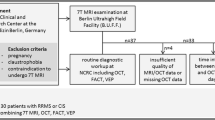Abstract
A retrospective study was conducted to investigate whether the use of low-contrast stimuli in addition to the standard high-contrast stimuli would increase the sensitivity of the pattern-reversal P100 when testing for multiple sclerosis (MS) and optic neuritis (ON). We found that there was a statistically significant increase in the number of abnormal results when using 25′ checks, but not for 50′ checks. Examination of patient records showed that VEP abnormalities to low-contrast stimuli only was not prognostic for subsequent development of multiple sclerosis.
Similar content being viewed by others
References
AM Halliday WI McDonald J Mushin (1972) ArticleTitleDelayed visual evoked response in optic neuritis. Lancet 1 IssueID7758 982–5 Occurrence Handle4112367 Occurrence Handle1:STN:280:CS2C2srmslY%3D
WI McDonald A Compston G Edan D Goodkin HP Hartung FD Lublin et al. (2001) ArticleTitleRecommended diagnostic criteria for multiple sclerosis: guidelines from the International Panel on the diagnosis of multiple sclerosis. Ann Neurol 50 IssueID1 121–7 Occurrence Handle10.1002/ana.1032 Occurrence Handle1:STN:280:DC%2BD38%2FitFOhug%3D%3D Occurrence Handle11456302
GS Gronseth EJ Ashman (2000) ArticleTitlePractice parameter: the usefulness of evoked potentials in identifying clinically silent lesions in patients with suspected multiple sclerosis (an evidence-based review): report of the quality standards subcommittee of the American academy of neurology. Neurology 54 IssueID9 1720–5 Occurrence Handle10802774 Occurrence Handle1:STN:280:DC%2BD3c3msVCnsg%3D%3D
KH Lee SA Hashimoto JP Hooge LF Kastrukoff JJF Oger DKB Li et al. (1991) ArticleTitleMagnetic resonance imaging of the head in the diagnosis of multiple sclerosis: a prospective 2-year follow-up with comparison of clinical evaluation, evoked potentials, oligoclonal banding, and CT. Neurology 41 IssueID5 657–60 Occurrence Handle2027480 Occurrence Handle1:STN:280:By6B38nmsF0%3D
AL Hume SG Waxman (1988) ArticleTitleEvoked potentials in suspected multiple sclerosis: diagnostic value and prediction of clinical source. J Neurol Sci 83 IssueID2-3 191–210 Occurrence Handle3128646 Occurrence Handle1:STN:280:BieC1cjntFQ%3D
WB Matthews JR Wattam-Bell E Pountney (1982) ArticleTitleEvoked potentials in the diagnosis of multiple sclerosis: a follow up study. J Neurol Neurosurg Psychiatry 45 IssueID4 303–7 Occurrence Handle10.1136/jnnp.45.4.303 Occurrence Handle7077339 Occurrence Handle1:STN:280:Bi2C1M7ntVc%3D
G Filippini GC Comi V Cosi L Bevilacqua M Ferrarini V Martinelli et al. (1994) ArticleTitleSensitivities and predictive values of paraclinical tests for diagnosing multiple sclerosis. J Neurol 241 IssueID3 132–7 Occurrence Handle8164014 Occurrence Handle1:STN:280:ByuB3MnptV0%3D
Anonymous (1994) ArticleTitleGuideline nine: guidelines on evoked potentials. American electroencephalographic society. J Clin Neurophysiol 11 IssueID1 40–73
JM Bland DG Altman (1986) ArticleTitleStatistical methods for assessing agreement between two methods of clinical measurement. Lancet 1 IssueID8476 307–10 Occurrence Handle1:STN:280:BimC3MjhvFc%3D Occurrence Handle2868172
JV Odom M Bach C Barber M Brigell MF Marmor AP Tormene et al. (2004) ArticleTitleVisual evoked potentials standard (2004). Doc Ophthalmol 108 115–23 Occurrence Handle15455794
Author information
Authors and Affiliations
Corresponding author
Rights and permissions
About this article
Cite this article
Davidson, A.W., Scott, R.F. & Mitchell, K.W. The effect of contrast reduction on pattern-reversal VEPs in suspected multiple sclerosis and optic neuritis. Doc Ophthalmol 109, 157–161 (2004). https://doi.org/10.1007/s10633-004-3831-9
Accepted:
Published:
Issue Date:
DOI: https://doi.org/10.1007/s10633-004-3831-9




